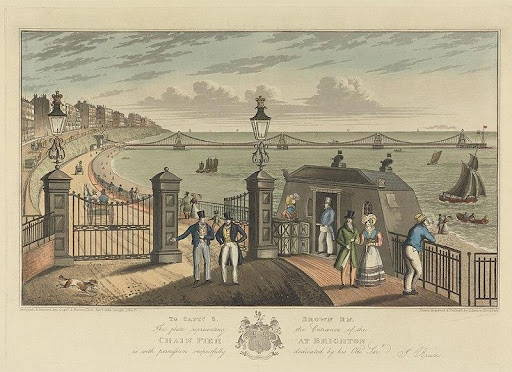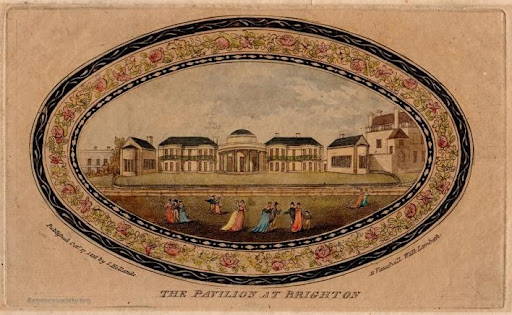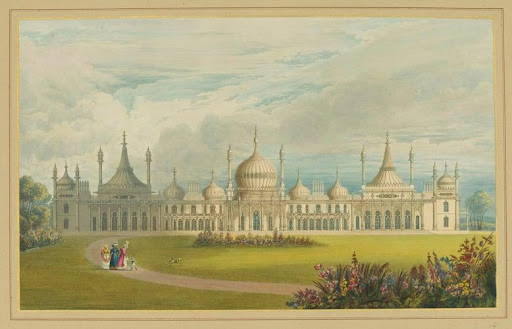Adelaide Magnolia Letter 8 – Holidays
Brighton and the Royal Pavilion

Chain Pier at Brighton. John Bruce c. 1830. Courtesy of Yale Center for British Art.
When the rich or famous start to like something, other’s follow. And so it was back in Regency times with Brighton, a fishing town on the Sussex coast, South of London. In 1771 the Duke of Cumberland, brother to King George III started coming to Brighton, which had started becoming a popular destination to partake in the medicinal benefits of swimming in and drinking sea water, toted by many doctors. In 1783, his nephew, the Prince of Wales visited him there. The Prince, who later was Prince Regent, then King, continued to visit Brighton, adding to the allure of the seaside location and its popularity.
Brighton offered its visitors many of the same delights and entertainments they could find in London, such as ballrooms and card rooms. But it also offered them the delight of sea bathing.
Sea bathing for women was a challenge for preserving their modesty. In order to allow women to sea bathe, a bathing machine was invented in the early 1700’s by Benjamin Beale. Imagine a covered carriage, pulled either by a horse or a bathing woman called a “dipper” into the water. Inside the carriage the women was allowed privacy to change her clothing into a bathing costume, like a cotton or muslin shift. When the cart was pulled deep enough into the water, the side facing the sea was opened with concealing canopies and stairs that let down into the water. This allowed the woman to step into the water with the help of her bathing woman and without anyone seeing her immodest attire.

The Pavilion at Brighton. S. Holland. 1818. Courtesy of Society of Brighton Print Collectors

Perspective View of the Steyne Front. James Tingle. 1838. Courtesy of The Royal Collection Trust.
The Prince of Wales was so enamored with Brighton that he even built his own residence there. In 1786 he leased an old farmhouse and established his long-time companion, Maria Fitzherbert there. Then in 1787 he purchased the house and surrounding land and commissioned architect Henry Holland to expand the house considerably to include a central rotunda in his very neo-classical style. The structure became known as the Marine Pavilion. In 1801, the Prince decided to enlarge his Brighton residence once again and enlisted the help of Peter Fredrick Robinson, a colleague of Holland’s, to expand the building to include a new dining room and conservatory.
In 1811, The Prince of Wales became the Prince Regent when his father, George III was deemed incapable of acting as monarch. The Marine Pavilion still didn’t meet the Prince Regent’s needs as a location for large social events. Consequently, in 1815, Henry Nash was commissioned to transform the modest villa into an opulent palace. The construction took many years, but Nash was able to transform the neo-classical Marine Pavilion into the very Indo-Islamic Royal Pavilion that we can still see today. The palace is very striking with minarets, domes, and pinnacles adorning the starkly white exterior. To this day it remains as a popular tourist destination as well as a popular wedding venue.
Michaelmas

Archangel Michael Defeats Satan. Guido Reni c. 1635. Altarpiece. Image courtesy of Santa Maria della Concezione dei Cappuccini.
In Medieval England, the changing of summer to fall was marked by Michaelmas, and signaled the need to finish the harvest and prepare for the cold season and shorter days ahead. It is traditionally celebrated on September 29th by Christian religions. They mark the occasion with a feast, honoring St. Michael and more generally all angels. In the Eastern Orthodox Church, it is a celebration on November 8th honoring all archangels. St. Michael is venerated as the greatest of all angels in Christian tradition, especially because he was the one that defeated Satan in the War in Heaven.
The biggest traditions for a Michaelmas meal were to have a goose, blackberries, and Bannock. Michaelmas was also known as “Goose Day” and there are even Goose Fairs held today that started as geese and animal trade events, many of which are now annual funfairs. It is said the tradition of eating a goose on Michaelmas started when Queen Elizabeth heard about the defeat of the Spanish Armada in 1588 while she was eating goose and vowed to always eat it on Michaelmas. Others followed her lead. It is said that eating goose on Michaelmas will protect you from financial struggles in the coming year; “Eat goose on Michaelmas Day, Want not for money all the year.”
The tradition of eating blackberries came from the story of the Archangel Michael defeating Satan. Lore holds that when Satan fell from heaven, he became the devil and fell straight onto a blackberry bush, cursing the fruit and making them unsafe to eat. British folklore states that Michaelmas is the last day it is safe to pick blackberries because that is the day Lucifer fell from the skies.
Traditionally the blackberries were eaten in a pie, but sometimes they are put in Bannock. Bannock is a traditional Michaelmas food that came from Scotland. It is an unleavened, flat quick-bread made of a blend of different flours, and can be either sweet or savory. The bread was eaten in remembrance of absent friends or those who have passed away and was given a special blessing at an early morning mass before being given away to the poor.
Learn the Vernacular:
Beethoven’s Piano Sonata No. 14: also known as Moonlight Sonata, is his most popular piano composition and was even popular in his own day
Chatsworth in Derbyshire: a stately country home; the seat of the Duke of Devonshire, owned by the Cavendish family since 1549.
House of Lords: the upper house of Parliament of the United Kingdom; also known as the House of Peers. Membership is by appointment, heredity, or official function.
Verdigris Green: verdigris refers to a blue-green pigment, such as the patina on copper.
Maladroit: ineffective or clumsy
Companionate Marriage: a marriage based on mutual consent and equality for companionship.
Sources:
https://www.historic-uk.com/CultureUK/Michaelmas/
https://en.wikipedia.org/wiki/Michaelmas
https://www.nationalgeographic.com/culture/article/michaelmas-the-day-the-devil-spit-on-your-blackberries
https://janeausten.co.uk/blogs/customs-and-manners/seabathing-georgian-style
https://janeaustensworld.com/tag/regency-sea-bathing/
https://brightonmuseums.org.uk/visit/royal-pavilion-garden/our-history/
https://en.wikipedia.org/wiki/History_of_Brighton
https://en.wikipedia.org/wiki/Royal_Pavilion
